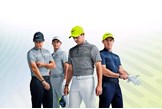Our exclusive interview with Rory McIlroy
Published: Last updated:
Rory McIlroy talks style, being an athlete and leading by example both on and off the course to Today’s Golfer.
He may be one of the biggest golfers on the planet, but Rory McIlroy is just like any other sports fan. Get him talking about football and he takes some stopping.
When he’s not on the course or in the gym, he’s at his happiest watching his beloved Manchester United. At the US Open, he even sprinted back to the clubhouse during a rain delay to catch the remainder of Northern Ireland’s game at the Euros.
But as it turns out, his obsession with sport stretches far beyond his day job.
Our meeting is taking place at the InterContinental London hotel which sits less than 400 yards from The 02 Arena – the same place where Rory had ringside seats for Anthony Joshua’s fight the night before.
He will be back on the fairways tomorrow and has already combined business with pleasure by putting some of the media through their paces in the gym, yet Rory appears a bundle of energy as he bounds into the room.
He openly admits that he likes to split his time between the course and the gym and it shows. He has turned himself into one of the fittest golfers around, putting on a reported 20 pounds in muscle in the last couple of years.
No wonder he’s often been touted as Tiger Woods’ heir apparent.
Like his idol, Rory has followed the same path to stardom. He was a child prodigy, breaking numerous records along the way, and won all but one of golf’s four Majors before the age of 25 – a feat matched only by Jack Nicklaus and Tiger.
The latter went on to redefine how the golfer looks and trains. Now Rory has picked up the baton and is taking things to the next level.
He inspired the design of Nike’s new Flyknit Elite shoes and broke tradition by pairing ‘joggers’ and a Fly Blade polo – Nike’s new collarless golf shirt – at The Players Championship in May.
McIlroy is only too happy to embrace the look of the ‘modern golf athlete’. He plans what he’ll be wearing at the big events a year in advance; he doesn’t hold back when sharing his opinions on the game with the world; and he’s relishing a role as a leader at September’s Ryder Cup at Hazeltine…

How much input do you have when it comes to the look of a new Nike shoe or golf club?
We work very closely together and there are always new ideas floating around. It was all new to me at first, but the relationship and partnership has evolved. Even today, we’ve been talking about next year, and as far as what we’ll be wearing in 2018/2019. Ultimately I’m the one who has to play and perform in the kit, so Nike wants to make it as good as they can for me, whether it’s a polo shirt or a shoe. I’m looking for performance; things that help on the golf course.
How has your style changed?
Everything has now become geared towards athleticism and performing better on the golf course, rather than just about style. You want to look good, but at the same time, you want to be comfortable in what you are wearing. Nike are very progressive and this athletic look is a great image to portray for the game – not just to attract golfers, but people who might want to get into golf. I’m all for it because I feel that strongly about it.
At some clubs golfers wouldn’t be allowed to play in a collarless shirt. Is that where golf gets it wrong, and isn’t as inclusive as it could be?
One of the best things and worst things about golf is its history. The tradition is great, and you have to respect it, but at the same time we have to realise we are living in the 21st century. Things move on and evolve so it’s a double-edged sword. The history of the game is what makes the game great. But at the same time, I think the history of the game sometimes holds it back.
You were quite outspoken about the USGA’s handling of the Dustin Johnson rules debacle at the US Open. Was that another case of golf shooting itself in the foot?
Definitely. If the USGA can’t make a decision on the rules of golf – and there are so many rules – how are we supposed to make a decision as well?
I think common sense needs to win through. Basically, they turned one of the biggest tournaments of the year into a sideshow. There is a huge difference in a Major if you are one or two shots behind with four or five holes to play. It makes you change the way you play. They said that the practice strokes he took behind the ball caused the ball to move, but only the USGA thought that. No one else did. They shot themselves in the foot – but also the game as a whole.
There’s been a lot of debate recently around whether golf should be part of the Olympics. Do you think it would have made more sense making it an amateur-only event?
I think that’s not for me to say. I wasn’t part of the process. The R&A and some of the other governing bodies that run our sport thought it was a great idea to get golf into other markets and the Olympics is obviously a great platform to do that. But I have four Olympic Games a year [Majors] and that’s my pinnacle. That’s what I play for and what I’ll be remembered for. Some people argue it would have been better to send amateurs there, but the whole reason that golf is in the Olympics is because they want the best players to go and compete. Unfortunately, with where it is this year, people just aren’t comfortable going down there and putting themselves or their family at risk. I’d say if the Olympic Games were in most other cities or most other countries in the world this year, you wouldn’t find as many people not wanting to go.
Do you think golf has been embarrassed by the number of big-name withdrawals?
I don’t think it’s embarrassing for the game because most athletes dream of competing in the Olympics and winning an Olympic Gold. We haven’t. We dream of winning Claret Jugs and Green Jackets. Whether that makes golf look insular in any way, it’s just the way it is.
On a brighter note, your stunning approach into the 18th at the Irish Open was voted the Shot of the Month by fans, but is it true you preferred your second shot on 16?
In terms of shots under pressure when I needed to pull something off like that, the shot on 16 was right up there. It’s right up there with the best that I’ve hit. The 16th was the turning point in the tournament. I knew I was going to have to do something on the last three holes, but I sort of had it in the back of my mind that my length might be an advantage. I only had 238 yards to the front, 273 to the pin, and it was just a perfect 3-wood. It was exactly what I wanted to do.
Darren Clarke has you earmarked as one of his on-course leaders at Hazeltine next month. How do you feel about being one of the ‘veterans’ on the team at the age of 27?
It’s exciting. I’ve known Darren for 20 years so to play under him is going to be very special. At Celtic Manor in 2010 and Medinah in 2012, I didn’t really feel comfortable enough to take on the responsibility of being one of the leaders of the team. But at Gleneagles in 2014, I relished the opportunity. It probably helped that I was so close to Paul McGinley, but I turned up a day before everyone else because I wanted to send a message to the rest of the team. I probably wasn’t comfortable with it a few years ago, but I’m starting to grow into the role and accept the responsibility.
Are you expecting a bit of an American backlash after what happened in 2012?
There’a a lot of stuff going on. You’ve got a lot of young guys who have experienced a defeat in a Ryder Cup so they’re going to be up for it. Davis Love wants redemption for Medinah… But it doesn’t matter how many rookies we are going to have in the team, we are going to be just as motivated, perhaps even more so. A Ryder Cup away from home is, for me, the best. I loved Medinah and it was the best Ryder Cup experience I have had so far.


